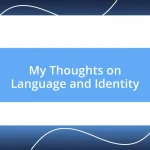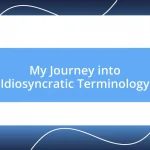Key takeaways:
- Language deeply influences personal identity, evoking emotions and memories tied to heritage and culture.
- Bilingualism adds layers to identity, enhancing self-expression and cognitive flexibility while navigating cultural contexts.
- Strategies like intergenerational transmission and community celebration help preserve language identity across generations, fostering belonging and authenticity.

Understanding language and identity
Language is more than just a means of communication; it’s a reflection of our identity. I remember when I moved to a new country and struggled with the local language. Every word I fumbled felt like a piece of my identity slipping away, and it made me realize how deeply intertwined language is with who we are.
When we speak our native language, it feels like slipping into an old, comfortable sweater. It wraps us in familiarity and warmth, evoking emotions and memories. Have you ever felt a swell of pride when using a certain phrase? That’s the power of language—it connects us to our heritage, culture, and personal history in ways we often overlook.
It’s fascinating to consider how bilingualism or multilingualism can shape our identities. I often switch between languages depending on who I’m with or where I am, and each shift brings out different facets of my personality. It makes me wonder, have you experienced something similar? Language shapes not only how we express ourselves but also how we perceive our place in the world.

Bilingualism and its identity impact
Bilingualism can profoundly influence how we see ourselves and relate to others. For instance, during my time in a multicultural workplace, I noticed that when communicating in another language, my demeanor changed. I felt more confident, more colorful in expressing my ideas. It was as if each language revealed a different aspect of my identity, adding layers to how I interacted with my colleagues.
- Bilingual individuals often navigate different cultural contexts, allowing for a rich tapestry in self-expression.
- Switching languages can empower individuals by unlocking new perspectives and ways of reasoning.
- Research suggests that bilingualism can enhance cognitive flexibility, influencing not just how we think but also how we identify.
- Many people find that certain languages evoke distinct emotional responses, highlighting the depth of cultural connections.
- Personal experiences of bilingualism can lead to feeling like a bridge between cultures, cultivating a unique sense of identity that embraces both worlds.

Language change and personal identity
When I reflect on how language changes over time, I can’t help but think about my own experience with slang. Growing up, the terms my friends and I used created a unique identity for us; they were like secret codes that forged bonds. As that slang fell out of favor, it felt like a part of my youth was lost. Isn’t it interesting how specific words can serve as markers of our identity at various stages of life?
Another fascinating aspect of language change is its connection to generational identity. I remember when I started using online chat platforms, and the rapid evolution of language within digital spaces amazed me. New abbreviations and emojis became part of my daily communication, making me feel acutely aware of the generational gap between my peers and older adults. Have you noticed how language shifts not only across regions but also between age groups? It’s a reminder that our identities continually adapt in response to the worlds we navigate.
As a language learner, I’ve felt firsthand how embracing new languages can reshape one’s sense of self. When I picked up a new language, it was like discovering a new version of myself. I noticed that my confidence fluctuated with my vocabulary. Each new word learned felt like stepping into a new part of my identity, crafting a more holistic view of who I am. Isn’t it intriguing how language acquisition can layer our identities, giving us complex and multifaceted selves?
| Language Change | Personal Identity |
|---|---|
| Shifts in slang reflect stages of life. | Terminology can mark friendships and relationships. |
| Generational lexicon varies significantly. | Language use reveals age-related identity nuances. |
| New languages open doors to different identities. | Identity evolves with language acquisition experiences. |

Strategies for preserving language identity
One effective strategy for preserving language identity is intergenerational language transmission. I deeply cherish the evenings I spent with my grandparents, listening to their stories in our native tongue. These conversations not only built my vocabulary but also fostered a connection to our family history. Does it surprise you how a simple act of storytelling can keep a language alive across generations? When young people actively engage with elders, it can create a strong sense of belonging and identity tied to linguistic heritage.
Another powerful approach is creating community spaces where the language is celebrated. I recall attending local cultural festivals that showcased our native language through music, dance, and poetry. It was exhilarating to see everyone proudly using our language, from young children to seasoned speakers. Have you ever felt that electric sense of pride when surrounded by others who share your linguistic background? Such environments not only boost collective identity but also encourage individuals to express themselves authentically in their language.
Additionally, utilizing technology can be a game changer in language preservation. I once stumbled upon online language-learning platforms that connected me with speakers from around the world, sparking invigorating conversations that kept my language skills sharp. Isn’t it fascinating how digital tools can bridge gaps and foster connections? When we leverage these resources, we not only enhance our fluency but also nurture our language identity in a globally connected world.












